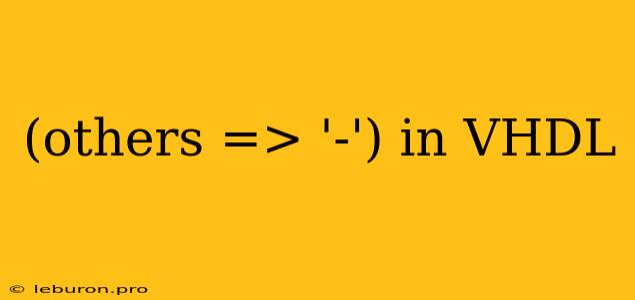In the realm of hardware description languages, VHDL (VHSIC Hardware Description Language) stands as a powerful tool for designing and modeling digital circuits. One of its fundamental features is the ability to define and manipulate various data types, including the versatile 'others' keyword. 'others' provides a convenient way to assign values to multiple elements of an array or record simultaneously, making it an indispensable tool for simplifying code and enhancing readability. This article delves into the intricacies of 'others' in VHDL, exploring its functionality, applications, and the importance of understanding its behavior for effective digital circuit design.
Understanding the Power of 'others' in VHDL
The 'others' keyword in VHDL is a powerful mechanism used for assigning values to multiple elements of a data structure with a single declaration. It simplifies the process of initializing arrays and records, particularly when dealing with large data structures or when the values of individual elements are not known beforehand.
Assigning Values to Array Elements
Consider a scenario where you need to initialize an array of eight bits, each representing a status flag. You might want to set all the bits to '0' initially. Using 'others', you can achieve this succinctly as follows:
signal status_flags : std_logic_vector(7 downto 0) := (others => '0');
In this code snippet, 'others' assigns the value '0' to every element in the array status_flags. This is far more concise than individually assigning '0' to each of the eight elements.
Assigning Values to Record Fields
'others' is equally effective for records. Suppose you have a record containing information about a sensor, including its ID, type, and calibration data:
type sensor_record is record
id : natural;
type : string(1 to 10);
calibration_data : std_logic_vector(15 downto 0);
end record;
signal sensor : sensor_record := (others => '0');
This code uses 'others' to initialize all the fields of the sensor record to '0'. This allows for a clear and efficient initialization without needing to explicitly set the initial values of each field.
Advantages of Using 'others'
- Conciseness: 'others' allows for concise and efficient code, reducing the verbosity of assigning values to multiple elements.
- Readability: The use of 'others' enhances code readability by providing a clear and concise way to understand the assignment of values to multiple elements.
- Maintainability: 'others' promotes maintainability by simplifying code modifications. If you need to change the default value, you only need to modify the 'others' assignment, rather than manually changing every individual element.
- Initialization Convenience: 'others' is particularly valuable for initializing arrays and records with a default value, as you don't need to know the exact number of elements or fields in advance.
Caveats and Considerations
While 'others' provides great benefits, it's important to be mindful of its limitations:
- Unsupported Data Types: The 'others' keyword is not supported for all data types in VHDL. It typically works with array and record data structures, but it's not applicable for scalar data types like integers or reals.
- Non-Constant Default Value: When using 'others,' the default value you specify must be a constant. You cannot use a variable or a function call as the default value.
Practical Applications in Digital Circuit Design
'others' proves invaluable across various digital design tasks:
- Initializing Memory Arrays: In memory design, using 'others' to initialize large memory arrays with a default value like '0' can significantly improve code readability and efficiency.
- Representing Unknown Values: 'others' is frequently used to represent unknown or undefined values in situations where the specific values are not yet known.
- Defining Default States: During the design of state machines, you can use 'others' to assign default states to state variables, ensuring a predictable initial condition.
- Assigning Default Values to Registers: When working with registers, 'others' can be used to initialize the register's content with a specific value, such as a reset value.
'others' in Different VHDL Contexts
- Signal Declarations: 'others' can be used in signal declarations to assign a default value to all elements of an array or record.
- Constant Declarations: You can also use 'others' to assign a default value to all elements of an array or record during constant declarations.
- Variable Declarations: 'others' can also be used in variable declarations to assign a default value to all elements of an array or record.
Conclusion
The 'others' keyword is a powerful tool in VHDL, offering a concise and efficient way to assign values to multiple elements of arrays and records. It enhances code readability, promotes maintainability, and simplifies the initialization of data structures. While it's not applicable to all data types, its versatility makes it a valuable asset for digital circuit designers. By understanding its functionality and limitations, you can leverage 'others' effectively to create clear, maintainable, and efficient VHDL code for your digital design projects.
